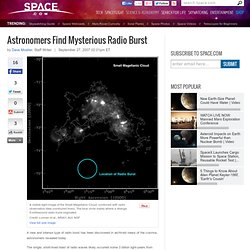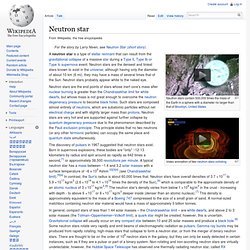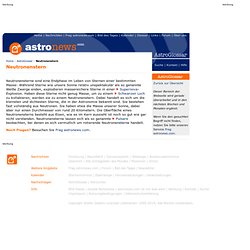

Astronomers Find Mysterious Radio Burst. A new and intense type of radio burst has been discovered in archived views of the cosmos, astronomers revealed today.

The single, short-lived blast of radio waves likely occurred some 3 billion light-years from Earth, and it may signal a cosmic car crash of two neutron stars, the death throes of a black hole—or something else. "This is something that's completely unprecedented," said Duncan Lorimer, an astrophysicist at West Virginia University in Morgantown and the National Radio Astronomy Observatory who led the discovery-making team. He noted that radio-emitting pulsars send out similar emissions, but repeat them every few hours. "We're confused and excited, but it could open up a whole new research field," Lorimer told SPACE.com of the 5-millisecond blip on the cosmic radar screen.
"If we really go after these things, we expect to find out that a couple hundred of them occur each day. " The discovery is detailed in the Sept. 27 issue of the online journal Science Express. Kilonova: Dead-Star Crashes May Spark Mysterious Cosmic Explosions. Cataclysmic crashes involving black holes and ultradense neutron stars may explain the briefest of the most powerful explosions in the universe, scientists say.

NASA scientists are calling the new type of short, but intense, cosmic collision and conflagration a "kilonova," an explosion so powerful it is 1,000 times stronger than a typical star explosion, called a nova. Such events have long been predicted by astronomers, but never seen until now, researchers said. The discovery could shed light on the origin of heavy elements such as gold and platinum, they added. Gamma-ray bursts are the most intense outbursts ever detected, giving off as much energy in an instant as our sun will beam out during its entire 10-billion-year lifetime. Gravity: Space-Time Warp. Einstein's Gravity Theory Passes Toughest Test Yet. An extreme pair of superdense stars orbiting each other has put Einstein's general theory of relativity to its toughest test yet, and the crazy-haired physicist still comes out on top.

About 7,000 light-years from Earth, an exceptionally massive neutron star that spins around 25 times a second is orbited by a compact, white dwarf star. The gravity of this system is so intense that it offers an unprecedented testing ground for theories of gravity. Scientists know general relativity, proposed by Albert Einstein in 1915, isn't the complete story. While it does very well describing large, massive systems, it's incompatible with quantum mechanics, which governs the physics of the very small. For something extremely small, yet extremely massive — such as a black hole — the two theories contradict each other, and scientists are left without a physical description. [6 Weird Facts About Gravity] Extreme pair Artist's impression of the J0348+0432 system.Credit: European Southern Observatory/J.
Strange Star Pair Confirms Einstein. X-Ray Binaries.
Neutron star. Neutron stars contain 500,000 times the mass of the Earth in a sphere with a diameter no larger than that of Brooklyn, United States A neutron star is a type of stellar remnant that can result from the gravitational collapse of a massive star during a Type II, Type Ib or Type Ic supernova event.

Neutron stars are the densest and tiniest stars known to exist in the universe; although having only the diameter of about 10 km (6 mi), they may have a mass of several times that of the Sun. Neutron stars probably appear white to the naked eye. Neutron stars are the end points of stars whose inert core's mass after nuclear burning is greater than the Chandrasekhar limit for white dwarfs, but whose mass is not great enough to overcome the neutron degeneracy pressure to become black holes.
Such stars are composed almost entirely of neutrons, which are subatomic particles without net electrical charge and with slightly larger mass than protons. Neutronenstern. Neutronensterne sind eine Endphase im Leben von Sternen einer bestimmten Masse: Während Sterne wie unsere Sonne relativ unspektakulär als so genannte Weiße Zwerge enden, explodieren massereichere Sterne in einer Supernova-Explosion.

Haben diese Sterne nicht genug Masse, um zu einem Schwarzen Loch zu kollabieren, werden sie zu einem Neutronenstern. Dabei handelt es sich um die kleinsten und dichtesten Sterne, die in der Astronomie bekannt sind. Sie bestehen fast vollständig aus Neutronen. Pulsare beobachten, bei denen es sich vermutlich um rotierende Neutronensterne handelt. Neutronenstern. Der Vela-Pulsar wurde im Jahr 1968 als erster direkter Beweis eines Neutronensterns als Resultat einer Supernova beobachtet.

Größenvergleich eines stellaren schwarzen Lochs, eines Neutronensterns und einer simulierten Stadt auf einer quadratischen Fläche mit einer Kantenlänge von 40 km Entdeckungsgeschichte[Bearbeiten] Im Jahr 1932 entdeckte Sir James Chadwick das Neutron[4] als Elementarteilchen und erhielt dafür 1935 den Nobelpreis für Physik. Bereits 1931, ein Jahr vor Chadwicks Entdeckung, schlug Lew Dawidowitsch Landau theoretisch die Existenz von Neutronensternen vor.[5] 1933 untersuchten auch Walter Baade und Fritz Zwicky Neutronensterne.[6] Sie beschrieben bei der theoretischen Erklärung der Vorgänge einer Supernova den Neutronenstern als mögliches Endprodukt der Sternentwicklung.
Robert Oppenheimer und George Michael Volkoff berechneten 1939 ein theoretisches Modell eines Neutronensterns und gaben die maximale Masse mit 0,7 M☉ an[7] (siehe auch Tolman-Oppenheimer-Volkoff-Grenze).